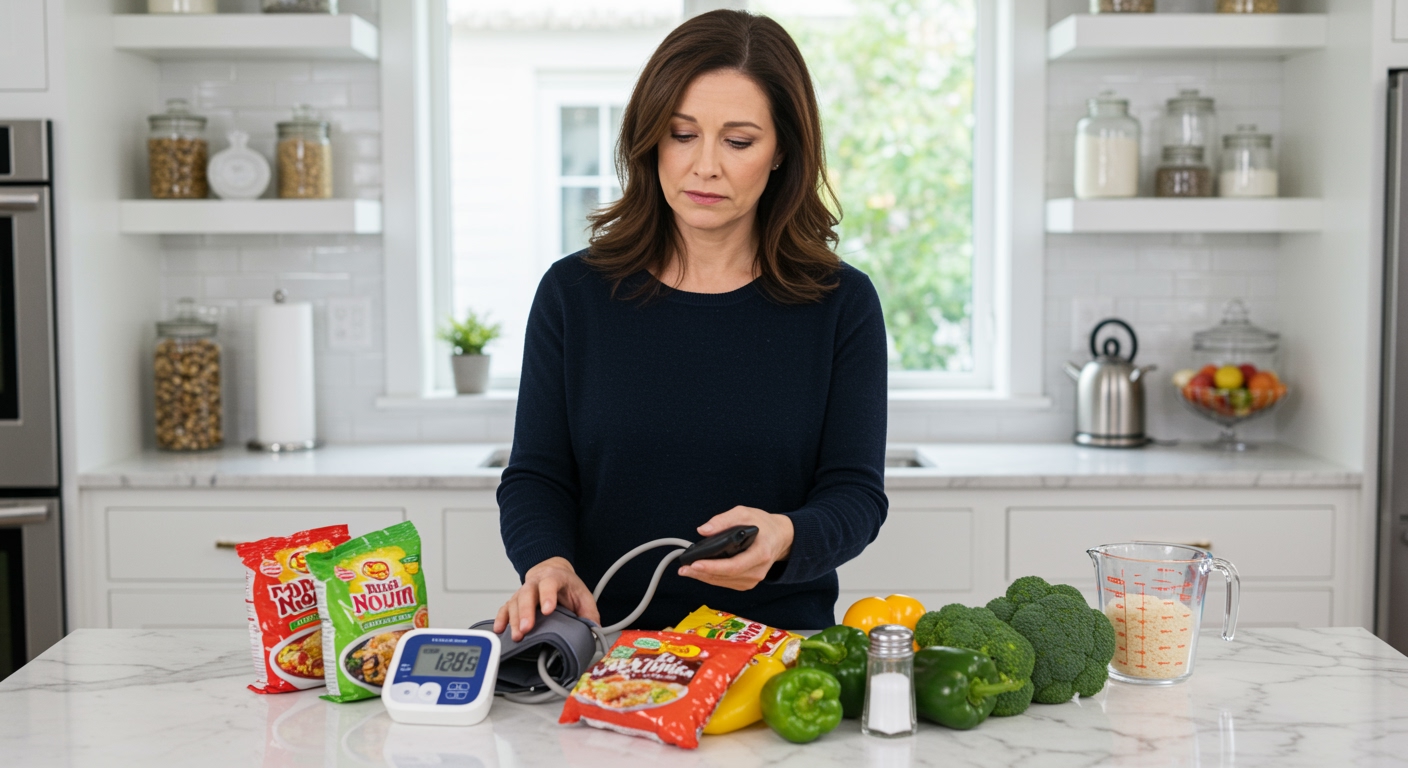✪ Key Takeaway: Not all instant foods are dangerous for hypertensive patients, but most contain excessive sodium that requires careful selection.
Introduction
Your doctor just told you that your blood pressure is too high and you need to change your diet immediately.
You stand in the grocery store aisle staring at rows of instant foods wondering if your busy lifestyle just became impossible to maintain.
Hi, I’m Abdur, your nutrition coach and today I’m going to explain exactly which instant foods you can still enjoy and which ones will sabotage your blood pressure goals.
What Makes Instant Foods Dangerous For Blood Pressure?
The primary culprit in most instant foods is sodium, which directly impacts your cardiovascular system in ways that many people do not understand.
When you consume high amounts of sodium, your kidneys struggle to filter the excess from your bloodstream.
This forces your body to retain more water to dilute the sodium concentration, which increases your blood volume significantly.
Your heart must work harder to pump this increased volume through your arteries, creating higher pressure against your arterial walls.
Most instant foods contain between 800 to 2000 milligrams of sodium per serving, while the American Heart Association recommends a maximum of 2300 milligrams per day for healthy adults.
For people with high blood pressure, the recommended limit drops to just 1500 milligrams daily, making a single instant meal potentially dangerous.
✪ Fact: One cup of instant noodles can contain up to 1400 milligrams of sodium, nearly your entire daily allowance.
Which Instant Foods Should You Definitely Avoid?
Instant noodles top the list of foods that hypertensive patients should eliminate from their diet completely.
These products contain not only excessive sodium but also preservatives like monosodium glutamate that can trigger additional blood pressure spikes in sensitive individuals.
Canned soups represent another major threat because manufacturers use sodium as both a preservative and flavor enhancer in concentrated amounts.
Frozen dinners often contain hidden sodium sources including sodium phosphates, sodium citrate, and other chemical compounds that your body processes as salt.
Instant mashed potatoes and flavored rice mixes contain dehydrated vegetables and seasonings that are loaded with sodium to maintain shelf stability.
Processed deli meats and instant breakfast sandwiches combine multiple high-sodium ingredients that create a perfect storm for blood pressure elevation.
✪ Pro Tip: Read nutrition labels and avoid any product with more than 400 milligrams of sodium per serving.
Are There Any Safe Instant Food Options?
Several instant food categories can fit into a blood pressure-friendly diet when you choose carefully and read labels thoroughly.
Plain instant oatmeal without added flavoring contains minimal sodium and provides soluble fiber that actually helps lower blood pressure naturally.
Unsalted instant brown rice offers convenience without the sodium overload, and you can add your own herbs and spices for flavor.
Some brands now manufacture low-sodium versions of popular instant foods that contain 50 percent less salt than traditional varieties.
Instant quinoa and other whole grain products often contain less sodium because they rely on the natural grain flavors rather than artificial seasonings.
Freeze-dried fruits and vegetables provide instant nutrition without any added sodium, making them excellent choices for quick meals and snacks.
✪ Note: Look for products labeled “no salt added” or “low sodium” to find safer instant options.
How Can You Make Instant Foods Healthier?
Smart preparation techniques can significantly reduce the sodium impact of certain instant foods while maintaining convenience.
When preparing instant noodles, use only half the seasoning packet and add fresh vegetables like spinach, carrots, or bell peppers for extra nutrition.
Rinse canned beans and vegetables under cold water for two minutes to remove up to 40 percent of the added sodium before using them in quick meals.
Create your own instant meal combinations by mixing plain grains with frozen vegetables and using herbs like garlic powder, oregano, and black pepper for flavor.
Dilute high-sodium instant soups with additional water or low-sodium broth to reduce the concentration of salt per serving.
Add potassium-rich ingredients like bananas, spinach, or avocado to instant meals because potassium helps counteract sodium’s blood pressure effects.
✪ Pro Tip: Prepare homemade instant meal kits on weekends using low-sodium ingredients for busy weekdays.
What Should You Focus On Instead?
Building a sustainable eating pattern around whole foods provides better blood pressure control than trying to navigate the instant food maze.
Fresh fruits, vegetables, lean proteins, and whole grains naturally contain less sodium while providing essential nutrients that support cardiovascular health.
Meal preparation techniques like batch cooking on weekends can create your own “instant” meals that are both convenient and heart-healthy.
Simple cooking methods like steaming vegetables, grilling proteins, and preparing grain salads require minimal time while maximizing nutritional benefits.
Learning to use herbs and spices effectively eliminates the need for high-sodium flavor enhancers in your daily meals.
Focus on creating sustainable habits rather than perfect restriction, because long-term consistency produces better blood pressure results than short-term extreme measures.
The Bottom Line
Most instant foods contain dangerous amounts of sodium that can worsen high blood pressure, but complete avoidance is not always necessary or practical for busy lifestyles.
Smart food choices require reading labels, not eliminating entire food categories, and this approach will serve your health better in the long run.
I would love to hear about your experiences with managing blood pressure through diet changes, so please share your questions or success stories in the comments below.
References
At NutritionCrown, we use quality and credible sources to ensure our content is accurate and trustworthy. Below are the sources referenced in creating this article:
- UC Davis Health: Your Guide to Low Sodium Eating and How to Lower Blood Pressure
- American Heart Association: Shaking the Salt Habit to Lower High Blood Pressure
- National Center for Biotechnology Information: Dietary Sodium Intake and Hypertension
- Spire Healthcare: The Effects of Fast Food on Your Body and Health





